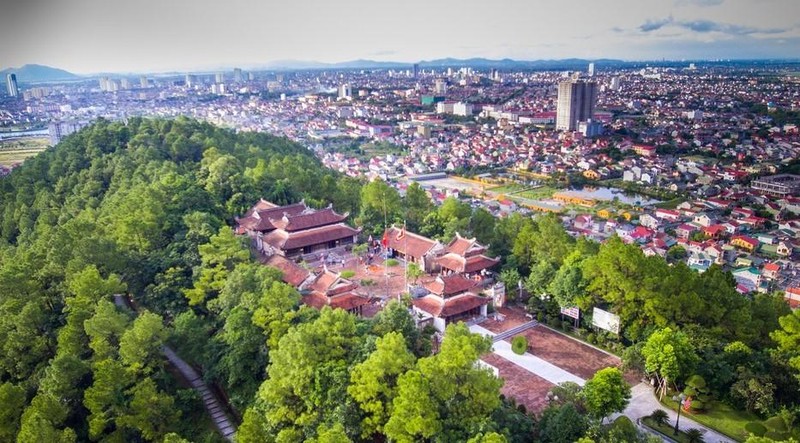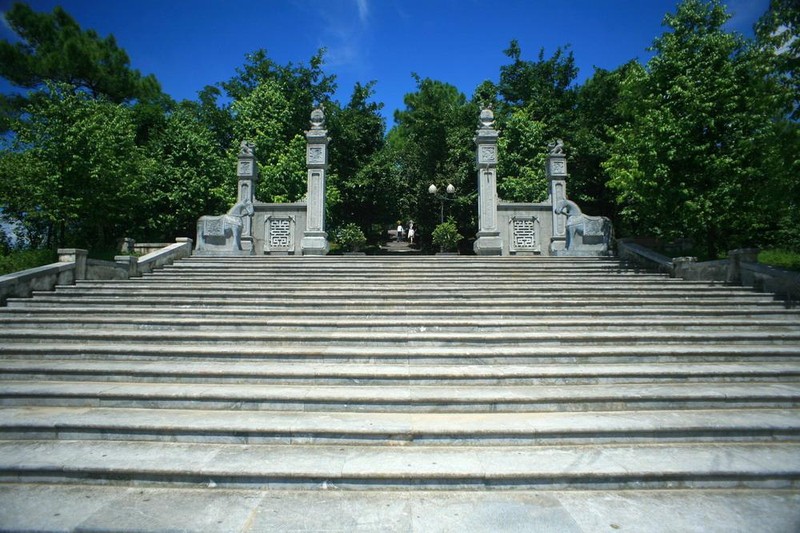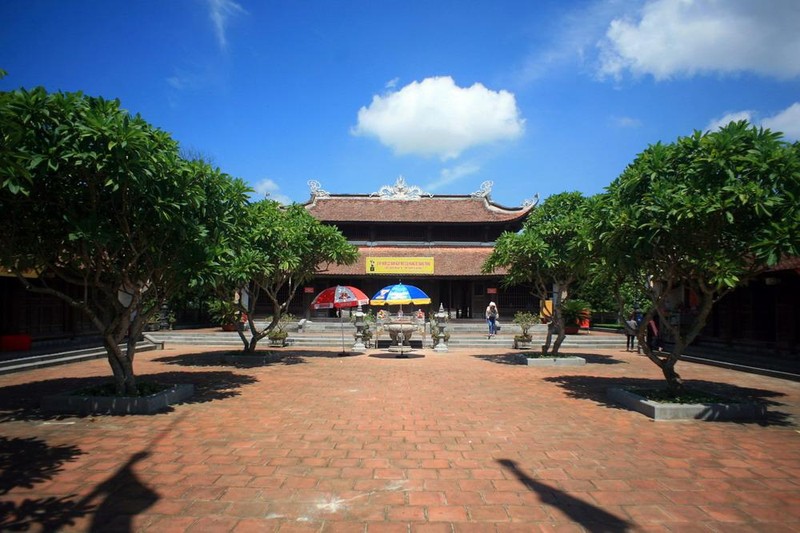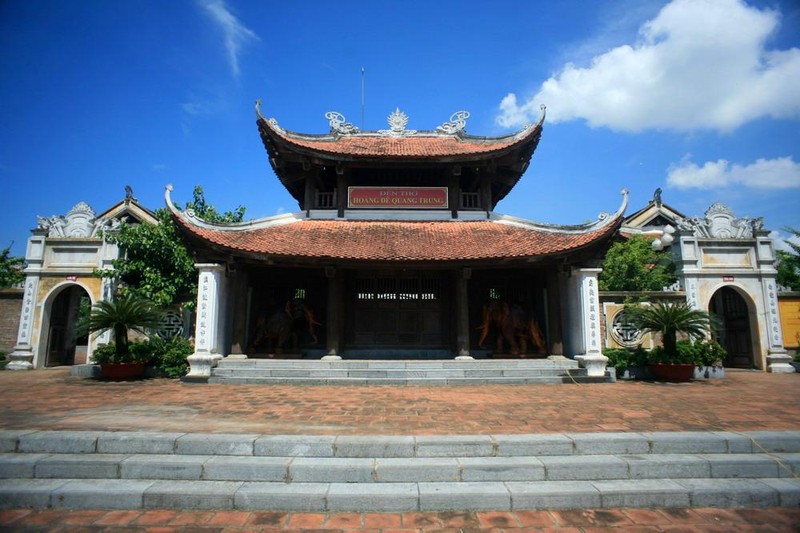This is also a red address to remind the young generation and all classes of people about the heroic historical figures and the proud and glorious history pages of the country’s history.
Phoenix Center Relics
Emperor Quang Trung Temple is an architectural work with many historical, spiritual and cultural values associated with the worship of the heroic king Quang Trung – Nguyen Hue. Therefore, when tourists come to Vinh city (Nghe An province), everyone seems to want to visit this famous temple.
The temple is located in a romantic pine forest with an altitude of 97m above sea level. From the top of the temple, you can see the whole city. Vinh, Red mountain, Lam river, Cua Lo beach, Ngu island, Eye island, Tien Dien village, hometown of great poet Nguyen Du…
King Quang Trung was the pillar of the Tay Son insurgent army, who had great merits in the cause of national reunification and national liberation. According to some researchers, the ancestors of the three Tay Son brothers were originally from Thai Lao village (Hung Thai commune, Hung Nguyen district, Nghe An province). In the years 1655 – 1660, this family was originally from the Ho family, followed the Nguyen Lord into Tay Son hamlet of Phu Ly district, Quy Nhon government, now Binh Dinh province to reclaim the newly expanded land. Here, the Ho family name changed to Nguyen, a few generations later gave birth to three brothers, Nguyen Nhac, Nguyen Hue and Nguyen Lu.
 Panoramic view of the Central Capital Phoenix from above. Panoramic view of the Central Capital Phoenix from above. |
In 1771, Nguyen Nhac together with two brothers, Nguyen Hue and Nguyen Lu, raised the flag of rebellion in Tay Son hamlet. In a short time, the Tay Son insurgents had mastered Cochinchina. After that, Nguyen Hue twice advanced to the North, in turn overthrowing King Le and Lord Trinh. In 1788, Nguyen Hue ascended the throne as Emperor, took the title of Quang Trung, founded the Nguyen Tay Son dynasty, then quickly pulled troops to the North to repel foreign invaders. On the way to advance, the king stopped in Nghe An to bury his army.
After defeating the Thanh army, Quang Trung clearly saw the strategic position of Nghe An land and the hearts of Nghe people, so he assigned Tran Thu Than and La Son’s son Nguyen Thiep to organize the construction of Trung Do Phoenix Citadel.
The book “Hoang Le Nhat Thong Chi” writes: “King Quang Trung thought that Nghe An was in the middle of the country, the roads from the South to the North and from the North were all equal, and his ancestral hometown was there, so he ordered the requisition of a lot of land. Many boatmen carry wood, stone, bricks and tiles to build palaces and castles. Build the citadel around and send soldiers to dig local laterite to build the inner city. Built a three-story dragon building at Thai Hoa Palace, two rows of corridors for rooms to use until the summer court ceremony. This citadel is called Trung Do Phoenix or Trung Kinh Phoenix Citadel.
 |
|
Stepping up 81 steps, the temple architecture appears majestic and ancient, typical for temple architecture in Vietnam.
|
More than a year later, after the great victory of the Spring of the Rooster 1789, in a leaflet sent to La Son’s son, Nguyen Thiep, Nguyen Hue Quang Trung once again affirmed that he had built the Trung Do Phoenix to build the capital in Nghe An. Although it was only built in a short and urgent time, the citadel already has inner citadel, outer citadel and Thai Hoa palace – where Emperor Quang Trung established his reign. Unfortunately, when the Phoenix Citadel had just been built, the plan to move the capital was still unfinished when the Emperor suddenly died.
Today, on the old dragon floor, the stele of Phuong Hoang Trung Do was established to mark the place where the citadel was located in the past. Phuong Hoang Trung Do is a heroic evidence showing the cultural vision of Nguyen Hue Quang Trung in the process of struggling to unify the country, building a peaceful, prosperous and happy life for the Vietnamese people.
Quang Trung Temple – an attractive spiritual and cultural tourist destination
The complex of scenic relics of Dung Quyet mountain and Trung Do Phuong Hoang has been recognized by the Ministry of Culture and Sports as a national scenic relic since 1962. By 2005, according to the people’s wishes and gratitude to the elder brother. In a cloth-clothed hero, the construction of the relic of Emperor Quang Trung’s temple was started.
On May 7, 2008, this historically significant building was inaugurated on the 220th anniversary of Trung Do Phoenix. The construction of the temple in the ancestral homeland of Emperor Quang Trung and the phoenix Trung Do relic belonging to the national landscape complex of Mount Dung Quyet and Phuong Hoang Trung Do – Vinh is very consistent with the spiritual and spiritual significance. history.
Located on Dung Quyet mountain, so to go to the temple, visitors will follow 1 km of winding mountain roads, enjoy the fresh air of nature, heaven and earth. Stepping up 81 steps, the temple architecture appears majestic and ancient, typical for temple architecture in Vietnam. The temple area is a four-pillar ritual, including a large gate and two small symmetrical gates on either side. The large gate is arranged on 2 floors and 8 roofs made of ironwood in the style of overlapping matches, all 3 gates are roofed with comedy nose tiles.
Next is a four-pillar screen made of stone with carved patterns. Behind the screen are two beer houses facing each other. The stele house on the right hand side includes a large bell and a stele engraved with a poem by President Ho Chi Minh written about Emperor Quang Trung with national pride. The stele house on the left hand side consists of a large drum and a stele engraved with the merits of Emperor Quang Trung, recording brilliant milestones in the Emperor’s great career.
 |
|
The Temple of Emperor Quang Trung is likened to a green pearl in the heart of the city.
|
Next is the left and right house, including 3 compartments, 2 wings made of ironwood. The right house is the house to welcome delegates and delegations to visit. The Left Vu House is a gallery of materials and artifacts related to the active life of Emperor Quang Trung and the Tay Son Dynasty. Between the two houses is a 1,500-square-meter yard with a garden of giant trees, bodhi trees and potted plants that blend into the space of a romantic pine forest.
The lower, middle, and upper halls are considered the center of the entire temple, designed in the shape of a triangle, rising gradually. All 3 houses are made of ironwood, carved with motifs in the style of the Nguyen Dynasty. The worshiping frame at the temple is arranged according to the traditional worship of the Vietnamese people, which is the post-holy Buddha. Notably, at the lower house is a great picture in Chinese characters, transliterated “Ngh Nghe Binh Sinh” which translates to: Nghe An is the homeland of the ancestors, and Binh Dinh is the place where the hero in cloth was born and raised.
Every year in the temple of Emperor Quang Trung, there are two solemn occasions: the 29th day of the 7th lunar month – the anniversary of Emperor Quang Trung’s death, and the 5th day of the first lunar month, which is the victory day of Ngoc Hoi – Dong Da. On these days, tourists from all over the world come here to enjoy the spiritual cultural values, admire the beautiful natural scenery, the sacred quiet atmosphere of the temple.
In the midst of the bustling city of Vinh, the temple of Emperor Quang Trung is likened to a green pearl in the heart of the city. The temple becomes an indispensable place in the spiritual travel manual of tourists when coming back to Nghe An. This is also a red address to remind the young generation and all classes of people about the heroic historical figures and the proud and glorious history pages of the country’s history.


 Panoramic view of the Central Capital Phoenix from above.
Panoramic view of the Central Capital Phoenix from above.